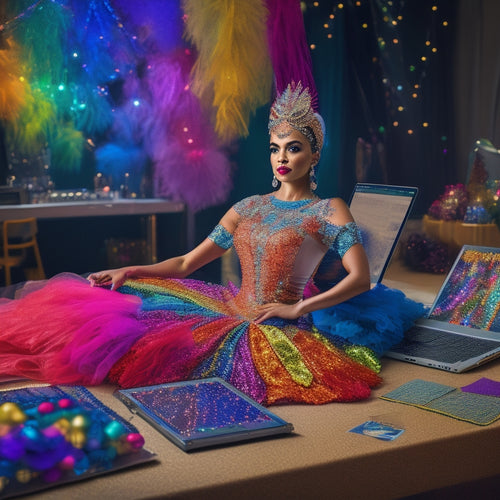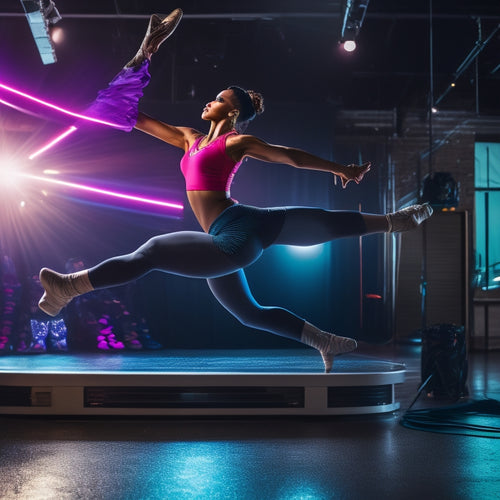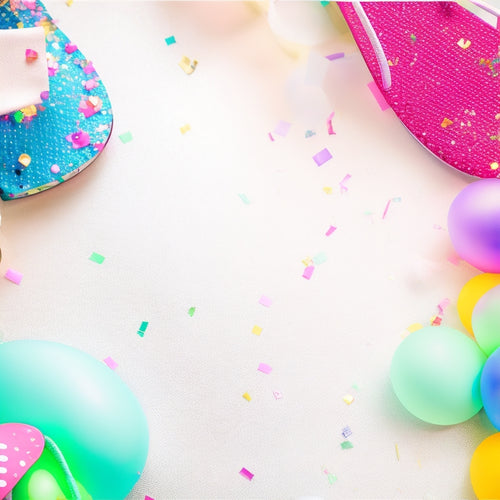
How Do You Make a Dance Costume Look Dirty?
Share
To make a dance costume look dirty, you'll want to create a worn-in appearance that looks authentic. Start by applying subtle stains and smudges, focusing on knees, elbows, and hemlines where dirt naturally accumulates. Use fabric paint, makeup, and dirt to add depth and character to the costume. Next, distress the fabric using sandpaper or deliberate tears and rips to create a battle-worn look. You can also use makeup to add grime and dirt effects, and experiment with color fading and layering techniques to achieve a convincingly dirty costume. From here, you can continue to build up layers of grime and texture to create a truly unique look.
Key Takeaways
• Apply fabric paint, makeup, and dirt to create a worn-in appearance, focusing on knees, elbows, and hemlines for natural dirt accumulation.
• Use deliberate tears and rips to create a distressed look, targeting areas prone to fraying or thinning over time.
• Employ makeup effects to create grime and dirt effects, focusing on muddy skin tones, grimy highlights, and dusty sheens.
• Distress fabric with sandpaper for a worn, rough texture, gently rubbing natural wear areas like seams and hems.
• Fade and blend colors for a natural, aged appearance, using Color Wash or Fabric Bleach to soften and mute colors.
Adding Subtle Stains and Smudges
Start by applying subtle stains and smudges to your dance costume using a combination of fabric paint, makeup, and dirt to achieve a distressed look that's not too over-the-top. You want to create a natural, worn-in look, not a costume that screams 'I just rolled around in the mud.'
Focus on areas that would naturally accumulate dirt, like the knees, elbows, and hemlines. Use a light hand when applying the stains and smudges, building up gradually to achieve a subtle, layered look.
As you add more dirt and grime, your costume will start to take on a worn, lived-in quality. The key is to create fabric wear that looks authentic, not contrived. By doing so, you'll add depth and character to your dance costume, making it look like it's been worn and loved for years.
Creating Deliberate Tears and Rips
You'll need to strategically rip and tear your dance costume to create a deliberately distressed look, carefully targeting areas that would naturally fray or wear thin over time.
Use scissors to create rough frays, cutting in a zigzag pattern to mimic the way fabric would naturally tear.
For a more dramatic look, use a craft knife to create fractured edges, carefully slicing through the fabric at an angle.
Be mindful of the costume's underlying structure, taking care not to compromise its integrity.
As you rip and tear, envision the dancer's movements, imagining where the fabric would naturally wear thin.
With each deliberate tear, you're crafting a unique, battle-worn look that tells a story of its own.
Using Makeup for Grime and Dirt
How can you effectively use makeup to create a grimy, worn-in look that complements the deliberate tears and rips, and adds an extra layer of authenticity to your dance costume?
To achieve this, focus on creating Muddy Skin tones and adding Grimy Highlights.
You can:
-
Use a mixture of brown and gray eyeshadow to create a dirty, worn-in complexion
-
Apply dark brown or black lipstick to create a smudged, grimy look
-
Add subtle, darker shades to your cheekbones and forehead to create depth and dimension
- Use a light brown or beige eyeshadow to add a subtle, dusty sheen to your skin
Distressing Fabric With Sandpaper
Take your fabric in hand and begin rubbing it gently with sandpaper, focusing on areas where wear and tear would naturally occur, such as the seams, hems, and any areas with deliberate tears or rips.
As you sand, you'll create fabric friction, which will help break down the fabric and give it a worn, rough texture. Use gentle, circular motions to avoid scratching the fabric.
Experiment with different sanding techniques, applying more pressure in areas where you want more distressing. Be careful not to sand too aggressively, as this can lead to holes or tears.
Fading Colors for a Worn Look
To achieve a truly worn look, your dance costume's colors need to fade and blend together, mimicking the natural effects of time and wear on the fabric. You can achieve this by using a Color Wash or Fabric Bleach to soften and mute the colors. This will give your costume a subtle, aged appearance.
Here are some ways to imagine the faded colors:
- Soft pink hues that have dulled to a blush tone
- Deep blues that have lightened to a soft sky blue
- Rich reds that have muted to a warm terracotta
- Vibrant greens that have faded to a mossy tone
Adding Dirt and Grime Textures
You can create a realistic, worn look by applying dirt and grime textures to your dance costume, carefully building up layers of subtle imperfections. To achieve this, you can use texture mapping techniques to add intricate details to your costume's fabric.
Start by applying a base layer of grime accumulation, using a combination of dark brown and gray shades to create a subtle, muted tone. Then, use a small brush to add finer details, such as streaks of dirt, smudges, and tiny scuff marks.
Be careful not to overdo it, as the goal is to create a subtle, worn look, not a costume that's caked in dirt. With patience and attention to detail, you can create a dance costume that looks like it's been through a vigorous rehearsal.
Creating Fake Sweat and Perspiration
Now it's time to create the illusion of sweat and perspiration on your dance costume.
You'll learn how to master sweat stain techniques, apply artificial moisture to give your costume a damp look, and craft realistic perspiration textures that will make your costume look like it's been worn for hours.
Sweat Stain Techniques
By mastering sweat stain techniques, you can convincingly convey the illusion of intense physical activity on your dance costume. To achieve this, you'll need to create realistic sweat stains that look like they've been earned through hours of intense movement.
Here are some tips to get you started:
-
Mix a small amount of water with a few drops of yellow or brown fabric paint to create a subtle, sweat-like stain.
-
Use a heat gun to set the stain and give it a slightly darker, more defined edge.
-
Apply a thin layer of fabric aging solution to the stain to give it a worn, faded look.
- Use stain artistry to create subtle, organic shapes that mimic the way sweat tends to spread and pool on fabric.
Artificial Moisture Application
Mastering artificial moisture application is essential when creating a truly convincing dance costume. It involves strategically applying fake sweat and perspiration to enhance the overall appearance of a well-worn, heavily used outfit.
You can achieve this by using mist effects to create a subtle sheen on the fabric. For a more dramatic look, try adding dew drops to specific areas, like the armpits or neckline, to create a beaded, sweat-like effect.
Mix a small amount of water with a fabric-safe adhesive and apply it to the desired areas using a pipette or small brush. This will create a realistic, three-dimensional effect that adds depth to your costume's worn appearance.
Perspiration Texture Creation
With your misted fabric sporting a subtle sheen, you can take the realism of your dance costume to the next level by creating a textured, raised effect that mimics the sticky, salty residue of dried sweat. To achieve this, focus on fabric absorption and sweat patterns.
You can use a mixture of water and glue to create raised, sticky patterns that resemble dried sweat. Apply the mixture to the fabric using a brush or a sponge, allowing it to dry and harden.
Here are some ways to enhance the texture:
- Apply the mixture in streaks or droplets to mimic the way sweat drips and runs down the skin.
- Use a heat gun to speed up the drying process and create a more textured, bubbly effect.
- Experiment with different glue consistencies to achieve varying levels of stickiness and texture.
- Add a few drops of saltwater to the mixture to give it a salty, sweat-like sheen.
Aging Fabric With Tea Staining
As you prepare to age your dance costume's fabric, you'll want to start by steeping the perfect brew - a strong, rich tea that will impart a deep, earthy tone to your fabric.
Next, you'll apply the tea stain to the fabric, carefully controlling the amount of liquid to achieve the desired level of discoloration.
Steeping the Perfect Brew
You'll be amazed at how a strong brew of black tea can transform pristine fabric into a distressed, vintage-look dance costume, perfect for conveying a character's rugged or worn appearance.
To achieve this look, you'll need to steep the perfect brew. Experiment with different brewing techniques, such as steeping time and temperature, to find the perfect balance for your fabric. Try using various tea varieties, like Assam or Ceylon, to create unique tones and shades.
Some tips to keep in mind:
- Use a strong brew to achieve a deeper stain
- Experiment with cold-brewing for a lighter tone
- Add a splash of vinegar to enhance the color
- Test the brew on a small, inconspicuous area first
Tea Stain Application
Now that you've got your perfect brew, dip a clean cloth into the tea solution, wring it out thoroughly, and apply it to your fabric in gentle, sweeping motions, working from the top down to achieve an organic, mottled effect.
The key is to maintain a consistent stain consistency by applying even pressure and avoiding blotchy areas. Adjust the brew strength to your liking, but keep in mind that stronger brews can result in darker, more pronounced stains. For a softer look, dilute the tea with water.
Don't be afraid to experiment and layer your stains to achieve a unique, worn look. Remember, the goal is to create a natural, aged appearance, so don't overthink it – just have fun and get creative!
Enhancing Fabric Texture
Dip a scrub brush into the tea solution and gently scrub the fabric in circular motions, working the stain into the weave to create a textured, worn appearance. This fabric manipulation technique enhances the tea stain, giving your costume a truly aged look.
As you scrub, imagine the fabric absorbing the tea, like parched earth soaking up rain.
- The soft bristles of the brush whispering against the fabric, teasing out the texture
- The tea solution seeping into the weave, like morning dew on a spider's web
- The fabric's natural fibers responding to the gentle scrubbing, like a lover's gentle caress
- The aged appearance emerging, like a flower blooming in the darkness
Building Up Layers of Grime
To create a convincingly dirty dance costume, start by applying a thin layer of grime using a combination of watered-down paint, ink, or fabric dye, carefully controlling the amount of liquid to avoid overpowering the fabric. This initial layer will provide a foundation for further grime accumulation.
| Grime Layer | Description |
|---|---|
| Initial | Thin layer of watered-down paint, ink, or fabric dye |
| Secondary | Add texture with fabric medium or modeling paste |
| Tertiary | Introduce color with acrylic or fabric paint |
| Quaternary | Seal with fabric sealant or varnish |
As you build up layers of grime, you'll achieve a dirty patina that adds depth and character to your dance costume. Remember to work in thin layers, allowing each layer to dry before adding the next. This will prevent overpowering the fabric and ensure a believable, worn look.
Frequently Asked Questions
Can I Use Household Items to Create Dirty Costume Effects?
You can creatively distress your dance costume using household items! Try dripping coffee or tea on the fabric to create realistic stains and tea rings, then blot with a paper towel to achieve a subtle, worn look.
How Do I Avoid Damaging Expensive Dance Costumes During Distressing?
"As you delicately dance around the issue, remember to treat your expensive costume with TLC. Research fabric care techniques and prioritize cost control to avoid costly mishaps, ensuring your costume stays radiant, not ruined."
Are There Any Safety Precautions When Using Makeup for Grime Effects?
"When using makeup for grime effects, you'll want to prioritize your skin's safety. Always do a skin test for makeup allergies before applying, and choose hypoallergenic products to minimize reactions, ensuring a comfortable and confident performance."
Can I Use This Technique on Delicate or Sensitive Fabrics?
"Before you splatter, smear, or drizzle, remember that not all fabrics are created equal; always test your grime effects on an inconspicuous area first, and choose materials that can withstand the creative chaos."
How Do I Remove Dirt and Grime Effects From Costumes After Use?
When you're ready to refresh your costume, gently hand-wash it in cold water with a mild detergent, then air-dry to preserve fabric integrity; for tougher grime, try a gentle fabric refresher spray or dry cleaning, and your costume will look like new again!
Related Posts
-

Design Stunning Dance Costumes With Online Tutorials
With online tutorials, you're just a click away from accessing stunning dance costumes that mesmerize the audience. D...
-

Take Your Dance Skills to the Next Level With These Accessories
You're ready to take your dance skills to the next level! With the right accessories, you can access new styles, impr...
-

Get the Dance Floor Popping: Wedding Flip Flops Sign
Create a memorable and entertaining wedding reception with a 'Get the Dance Floor Popping' flip flops sign that combi...


